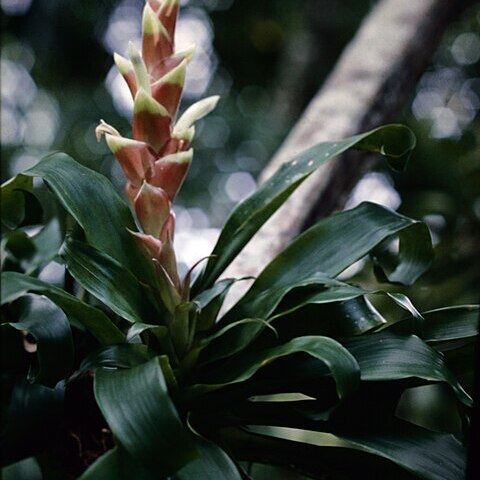Plant acaulescent, flowering to over 40 cm long, with a funnelform, 14-25 cm tall, rosette of 10-20 often pale-or rich green leaves. Leaves thin, chartaceous when dry, 12-25 cm long, equaling to much exceeding the scape; sheaths distinct, tapering into the blade, elliptic, broadly convex, 5-8 x 2.5-4 cm, with broad membranaceous margins, pale-brown punctulate-lepidote, pale-brown at the base; blades arching, (linear-) lanceolate, often involute at the base, 8-20 x 2-2.7 cm, triangular subacute or rounded and apiculate, subglabrous. Inflorescence erect, simple; scape 7-18 cm long, appearing stout and entirely hidden by bracts, glabrous; scape bracts erect, densely imbricate, the lower ones foliaceous, the upper ones ovate, apiculate, more than 4 times as long as the internodes, sparsely appressed-lepidote at the apex, pale-green and often tinged with red; raceme elliptic in outline to broadly cylindric, 8-20 x 4-6 cm, emarginate, (sub-) densely and distichously (immature?) or polystichously (caused by the twisting rachis) 4-12-flowered, with a few sterile bracts below and at the apex; rachis hidden, slightly flexuous, angled, glabrous; floral bracts suberect below and spreading in upper half, loosely sheathing the flower, submembranaceous, with finely veined surface (when dry), broadly ovate, 3-4.3 cm long, about 4 times as long as the internodes, exceeding (but exposing) the sepals, rounded or deltoid-acute, apiculate, often incurved at the apex, ecarinate, (sub-)glabrous outside, minutely brown-lepidote inside, yellow-green and often with a broad red band in the middle. Flowers suberect, short-pedicellate (ca. 4 mm); sepals thin-coriaceous, finely veined when dry, lanceolate, 2.5-3 cm long, obtuse and apiculate, short-connate and finely carinate posteriorly, minutely brown-lepidote only inside; petals erect, the blade spreading, ligulate, ca. 4.5 cm long, whitish, bearing two highly adnate and entire or emarginate ligules at the base; stamens exposed, but shorter than the petals, about equaling the pistil, filaments flat at the base, not dilated apically, anthers dorsifixed (at 1/3), linear-sagittate, basal free lobes and apex obtuse; ovary ovoid, tapering from near the base toward the apex, abruptly contracted into the slender style, stigmas linear. Capsule cylindric, 3.5-5 cm long, subrounded and long beaked.
More
Rarely over 4 dm. high. Leaves about 2 dm. long, green above, suffused with red and sometimes spotted below; sheaths distinct, obscurely punctulate-lepidote; blades ligulate, acute or acuminate, 15-30 mm. wide, subglabrous. Scape erect, usually much shorter than the leaves. Scape-bracts densely imbricate, broadly ovate, acute. Inflorescence simple, distichous, oblong in outline, dense, 6-to 18-flowered, to 20 cm. long, 6 cm. wide, strongly complanate. Floral bracts broadly ovate and triangular-acute or subrhombic, to 45 mm. long, chartaceous, sharply carinate with the keel sigmoid in outline, bright red above the middle, greenish yellow at apex and margins. Flowers erect or suberect, subsessile, 6 cm. long. Sepals lanceolate, acuminate, 27 mm. long, thin. Petals white, linear, acute, bear-ing 2 ovate obtuse scales. Stamens included. Capsule 5 cm. long. Coma reddish brown.

